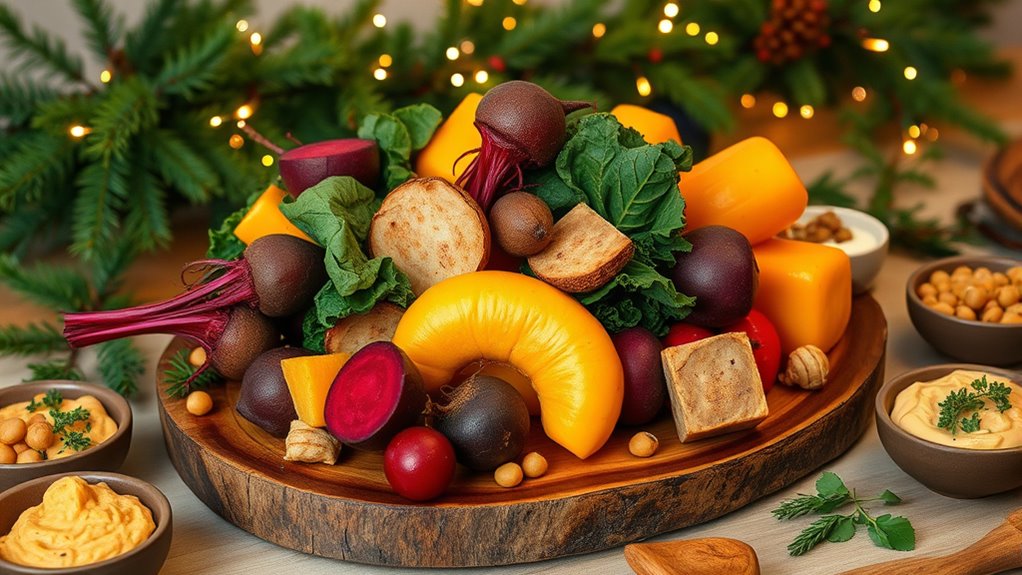To serve sustainable holiday meals, focus on local, seasonal, and plant-based ingredients that support your community and reduce environmental impact. Choose in-season produce like root vegetables, winter squash, and hearty greens, and incorporate plant-friendly options like lentil stews and roasted vegetables. Opt for eco-friendly packaging and creative presentation that minimizes waste. Embracing these practices helps create a festive, flavorful meal that’s kind to the planet—discover more ideas that make your celebration truly sustainable.
Key Takeaways
- Prioritize seasonal, locally sourced ingredients to ensure freshness, support local farmers, and reduce environmental impact.
- Incorporate plant-based dishes like roasted vegetables and hearty stews to create sustainable, nutritious holiday menus.
- Use eco-friendly packaging such as reusable containers, beeswax wraps, or biodegradable materials to minimize waste.
- Plan meals around seasonal flavors to enhance taste and nutrition while decreasing reliance on imported or out-of-season produce.
- Promote community health and environmental sustainability by choosing sustainably farmed ingredients and energy-efficient preparation methods.

The holiday season is a perfect opportunity to enjoy delicious meals while making eco-friendly choices. One of the easiest ways to do this is by focusing on seasonal ingredients. When you select produce that’s in season, you’re not only supporting local farmers but also reducing the environmental impact associated with long-distance transportation. Seasonal ingredients tend to be fresher, tastier, and more affordable, making your holiday feast more enjoyable and sustainable. Think about incorporating root vegetables like carrots and parsnips, hearty greens, or winter squash into your menus. These ingredients are at their peak during the holidays, so they provide maximum flavor and nutrition while minimizing your ecological footprint.
Another key aspect is choosing eco friendly packaging for your holiday meals and leftovers. Avoid single-use plastics and opt for reusable containers, beeswax wraps, or biodegradable options instead. When you buy ingredients, look for packaging made from recycled or compostable materials. This small change can profoundly cut down on waste and make your celebrations more environmentally responsible. If you’re giving gift baskets or party favors, consider wrapping items in fabric or craft paper that can be reused or recycled, rather than plastic wrap or foam containers. These simple swaps not only reduce waste but also add a charming, personal touch to your holiday presentation.
Planning your menu around seasonal ingredients also encourages you to think creatively about plant-based dishes. Many vegetables and fruits are at their best during winter months and can fill your table with hearty, satisfying options that are better for the planet. Roasted root vegetables, hearty lentil stews, or vegetable-based casseroles are excellent choices that highlight seasonal flavors while cutting down on meat consumption. Choosing sustainable farming practices can further enhance the eco-friendliness of your holiday meals. Not only does this support environmental health, but it can also make your holiday meals more inclusive for guests with dietary preferences or restrictions. Incorporating plant-based options also aligns with the concept of reducing meat consumption, which has a positive impact on the environment. Additionally, selecting ingredients that are locally sourced ensures freshness and supports community economies. Using energy-efficient appliances during meal preparation can further reduce your carbon footprint. By prioritizing seasonal ingredients, choosing eco friendly packaging, and supporting local farms, you’re making your holiday celebrations greener without sacrificing flavor or tradition. This approach helps create a festive atmosphere that celebrates the season and respects the planet, making your holiday meals truly meaningful.
Frequently Asked Questions
How Can I Reduce Food Waste During Holiday Celebrations?
To reduce food waste during holiday celebrations, you can start by planning your menu carefully to avoid overbuying. Use composting tips for scraps and vegetable peels, and get creative with edible leftovers to make new meals. Store leftovers properly, encourage guests to take extra servings, and share any excess food with neighbors or charities. These steps help minimize waste while making your celebration more sustainable and enjoyable.
What Are Eco-Friendly Alternatives to Traditional Holiday Serveware?
You can choose eco-friendly alternatives to traditional holiday serveware by using biodegradable plates, which break down naturally and reduce landfill waste. Opt for reusable utensils like stainless steel or bamboo, so you cut down on single-use plastics. These options not only lessen your environmental impact but also add a stylish touch to your celebration. Making these simple swaps helps you host a greener holiday without sacrificing convenience or festivity.
How Do I Source Local Ingredients for Holiday Meals?
To source local ingredients for your holiday meals, visit farmers markets in your area where vendors sell fresh, seasonal produce directly. You can also join a Community Supported Agriculture (CSA) program, which delivers farm-fresh goods straight to your door or pickup spot. These options guarantee you get high-quality, local ingredients while supporting nearby farmers and reducing your carbon footprint during the holiday season.
What Are Some Budget-Friendly Sustainable Holiday Meal Ideas?
Looking for budget-friendly sustainable holiday meal ideas? You can start by using budget-friendly ingredients like seasonal vegetables and grains. Incorporate plant-based substitutions such as lentils instead of meat or tofu as a protein source. Plan your meals around local, in-season produce to save money and reduce environmental impact. These simple swaps help you create delicious, eco-conscious feasts without overspending, making your holiday celebrations both festive and sustainable.
How Can I Involve Children in Sustainable Holiday Cooking?
You can involve children in sustainable holiday cooking by encouraging family participation in simple, creative cooking activities. Let them help wash vegetables, assemble salads, or decorate dishes, making the process fun and educational. Use this time to teach them about local ingredients and plant-based options, fostering their interest in sustainable eating. By engaging them actively, you create memorable moments and inspire healthy, eco-friendly habits for the future.
Conclusion
So, there you have it—ditch the giant turkey and imported veggies, and embrace a planet-friendly feast. Who knew saving the Earth could taste so good? This holiday, impress your guests with your eco-conscious choices—after all, there’s nothing more festive than a plant-based, locally-sourced masterpiece that leaves both your conscience and the planet a little happier. Bon appétit! Remember, the only thing you should be overcooking is your guilt.










